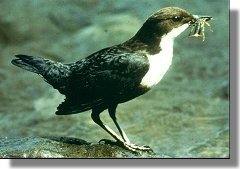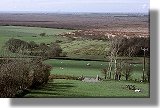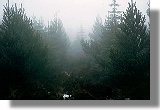|
Present
Today the rivers of Wales can be divided into two major types. The short, steep rivers of the north and west are cold, poor in nutrients and fast flowing. In contrast the rivers of the east, which arise in the same mountains, make a slower and longer progression to the sea with extensive floodplains in their lower sections.
 This environmental canvas supports a wealth of riverine wildlife. Chemical processes at a microscopic level power the ecosystems of Welsh rivers, with structurally ornate micro-organisms (such as moving towers of bacteria and encrustations of algae) creating this invisible brew. Thin leaved, low growing mosses and lichens are ideally adapted to the swiftest streams, especially if a woodland canopy retains the humid environment. In calmer waters, flowering plants are found submerged in the water, floating on the surface or growing along the banks, where they trap sediment and provide crucial habitats for invertebrates and fishes. Ecology students sampling these rivers will find a great abundance of snails and insects larvae; food for the dipper! Salmon, sea trout, lampreys, shad and eels are the characteristic migratory members of the fish fauna but humans have introduced additional fish species from other parts of Britain. There is an extensive inventory of endangered species living in Welsh rivers, including the floating water plantain, the southern damselfly, the white-clawed crayfish, freshwater pearl mussel, shad and the water vole. This environmental canvas supports a wealth of riverine wildlife. Chemical processes at a microscopic level power the ecosystems of Welsh rivers, with structurally ornate micro-organisms (such as moving towers of bacteria and encrustations of algae) creating this invisible brew. Thin leaved, low growing mosses and lichens are ideally adapted to the swiftest streams, especially if a woodland canopy retains the humid environment. In calmer waters, flowering plants are found submerged in the water, floating on the surface or growing along the banks, where they trap sediment and provide crucial habitats for invertebrates and fishes. Ecology students sampling these rivers will find a great abundance of snails and insects larvae; food for the dipper! Salmon, sea trout, lampreys, shad and eels are the characteristic migratory members of the fish fauna but humans have introduced additional fish species from other parts of Britain. There is an extensive inventory of endangered species living in Welsh rivers, including the floating water plantain, the southern damselfly, the white-clawed crayfish, freshwater pearl mussel, shad and the water vole.
 It is important not to think of rivers as only a summer channel with flowing water. Under winter high water levels, rivers extend into their floodplains where they help to maintain the biodiversity of the surrounding landscape. Bogs, swamps, fens and woodlands are very dependent on this natural ecological expansion. A meandering river can also create new habitats, such as oxbow lakes. All these wet areas attract a range of additional wildlife, such as otters, water voles, bats and wintering populations of geese and ducks. It is important not to think of rivers as only a summer channel with flowing water. Under winter high water levels, rivers extend into their floodplains where they help to maintain the biodiversity of the surrounding landscape. Bogs, swamps, fens and woodlands are very dependent on this natural ecological expansion. A meandering river can also create new habitats, such as oxbow lakes. All these wet areas attract a range of additional wildlife, such as otters, water voles, bats and wintering populations of geese and ducks.
However, the natural movement of water between the river channel and its floodplain has been seriously disrupted by flood defense structures and drainage schemes. This usually leads to the drying out and environmental deterioration of the floodplain wetlands. The original channel hydrology can also be affected by water abstractions, and by the storage and release of water from reservoirs. Typically a dam is built in the headwaters to store water during high rainfall and release it during dry periods. The upstream part of the river is thereby transformed into a lake-like ecosystem, with a disruption to the free movement of fishes and other species. In some cases, large-scale hydroelectric schemes have been installed in the dam wall. Downstream river processes will also alter without a natural flood cycle. For example, the channel width will decrease and vegetation will colonize shingle islands. The River Wye is thought to be a relatively good example of a river system still exhibiting natural flow patterns. Water is usually completely lost from a river system when it is taken for public or industrial uses but some may be returned as part of chemically altered wastewater discharges.
 Agricultural grasslands now make up almost 70% of the land use on the fertile soils of Welsh floodplains and only small fragmented natural pockets of wet grassland, woodland and wetlands persist. In the uplands, extensive areas are covered with coniferous forestry plantations. The planting and growth of these trees comes with risks to fresh water from drainage, fertilizer use and other hydrological changes. If clear-felled, in a single action the plantation effects are suddenly reversed leading to more ecosystem disturbance and other environmental risks, such as sediment run-off from tracks. Agricultural grasslands now make up almost 70% of the land use on the fertile soils of Welsh floodplains and only small fragmented natural pockets of wet grassland, woodland and wetlands persist. In the uplands, extensive areas are covered with coniferous forestry plantations. The planting and growth of these trees comes with risks to fresh water from drainage, fertilizer use and other hydrological changes. If clear-felled, in a single action the plantation effects are suddenly reversed leading to more ecosystem disturbance and other environmental risks, such as sediment run-off from tracks.
Read more in The Rivers of Wales
|